royal botanic garden sydney
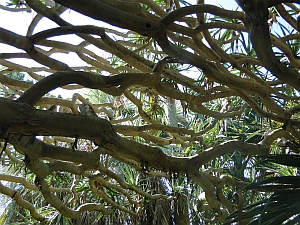 Dragon's blood tree
Dragon's blood tree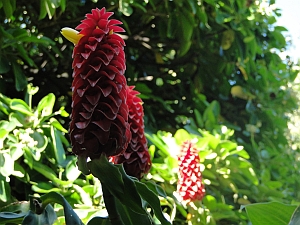 Red tower ginger
Red tower ginger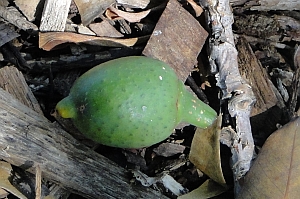 Strangler fig fruit
Strangler fig fruitThe Royal Botanic Garden Sydney was full of the most incredible plants and trees. Join me on a speedy walkabout - Mother and friend are patiently waiting in a cafe! - and take in some of the wonders of the garden's collection.
first stop at the royal botanic garden sydney - a wollemi!
The first tree I bumped into was a Wollemia nobilis - the Wollemi pine. And this particular tree grows in the place of the famous Wishing Tree, a Norfolk Island pine, which had to be taken out in 1945 due to "old age and decay" as the plaque next to the Wollemi informed me.
Next to the pine, in memory of the Wishing Tree - a bust, named "I Wish" which is made of pink concrete and which dates from 1946, by the sculptor Arthur Fleischmann:
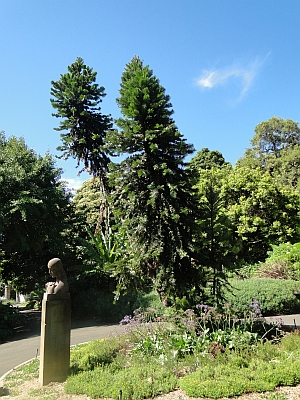 Wollemi pine with the "I Wish" statue
Wollemi pine with the "I Wish" statue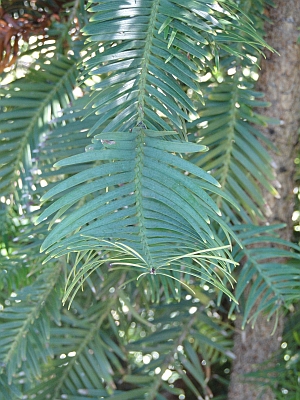 Wollemi pine leaves
Wollemi pine leavesThe Wollemi is not a true pine; it really belongs to one of the most exciting of tree families, for me, at least: the Araucariaceae, to which the monkey puzzle and the Norfolk Island pine also belong.
Another member of this family is Araucaria cunninghamii, the hoop pine. The specimen below is rather a baby tree and is hidden in plain sight. It's in front of the giant palm in the background, and has a very thin trunk at the moment with small branches and dark green leaves sticking out near the bottom of the trunk, in the middle, and at the top!
But at least I've seen it and it's another Araucariaceae tree to add to my collection:
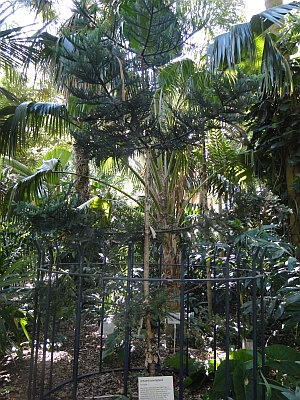 The hoop pine
The hoop pineThis is just a close-up from the same photograph of the branches and leaves:
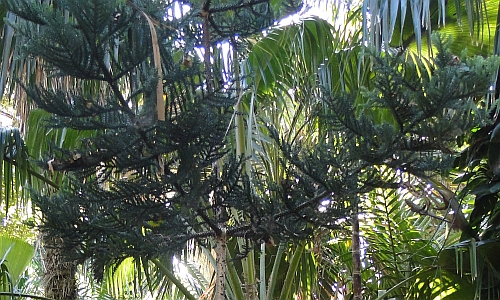 Detail of hoop pine branches and leaves
Detail of hoop pine branches and leavesNative to New Guinea, Queensland and New South Wales, the hoop pine's label told me it's found in rainforests, rocky gorges and by stream banks, and the timber is used for cabinet making amongst other things, so a valuable wood.
I've only seen one other hoop pine - in Melbourne; we'll meet a Norfolk Island pine at the end of the walk below.
face to face with the big trees
Yes - many of the trees I saw in Sydney Botanic garden were enormous - almost too big to photograph, apart from those with some decent space around them.
My next tree is tall and thin - and boy, did I love it! Here's Syagrus romanzoffiana - the Queen palm, or the cocos palm, and called pindo in Spanish!
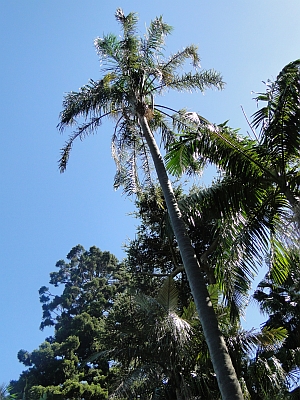 Looking up: the Queen palm
Looking up: the Queen palm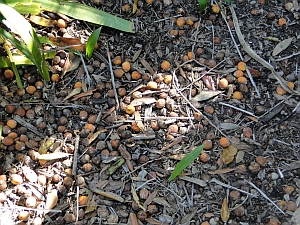 Looking down: Queen palm fruit
Looking down: Queen palm fruitThe wind was blowing and the Queen palm was in full action mode, so I took a quick video:
******************
Now for something a little different: Toona ciliata, the red cedar.
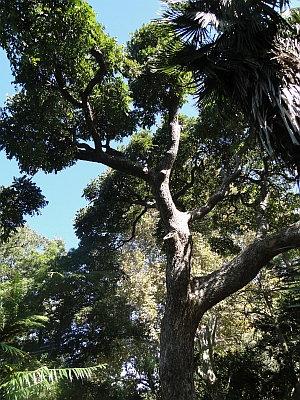 Red cedar
Red cedar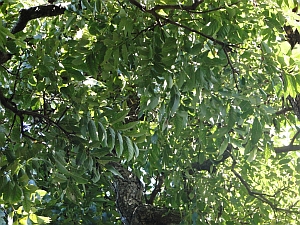 Red cedar leaves
Red cedar leaves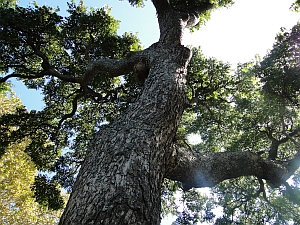 Impressive red cedar trunk
Impressive red cedar trunk******************
My trip to the Royal Botanic Garden Sydney gave me the opportunity to meet this interestingly named tree: Waterhousea floribunda, the weeping lilli pilli or weeping myrtle.
This tree was planted in 1828 using "material collected on the banks of the Brisbane River":
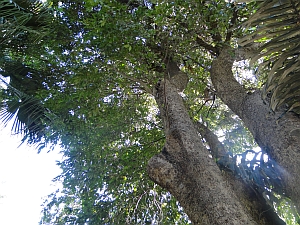 Weeping lilli pilli tree
Weeping lilli pilli tree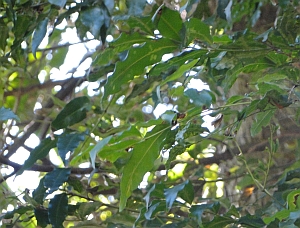 Weeping lilli pilli leaves
Weeping lilli pilli leaves******************
Glancing down a nearby path, my first thought was "What the heck is that over there?!"
You'll know the answer if you spotted the little pic of this tree's branches at the top of the page ;)
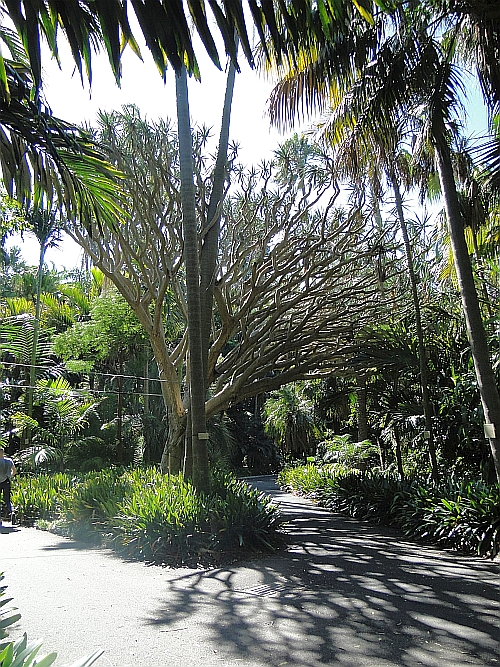 Great shape, great shadows!
Great shape, great shadows!The dragon's blood tree :)
Another new experience - I could have spent all day just looking at the shape of Dracaena draco, the dragon's blood tree!
This tree was planted in the early 1860s and is believed to be the oldest such specimen in Australia.
Here's a shot from the other side:
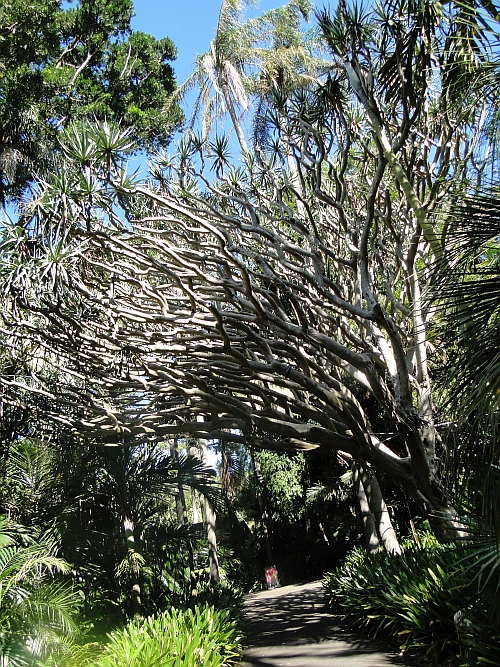
Also called the Canary Island's dragon tree or drago, the "blood" refers to the red resin secreted from both leaves and bark. Notice the aerial roots growing from the tree's bottom branches:
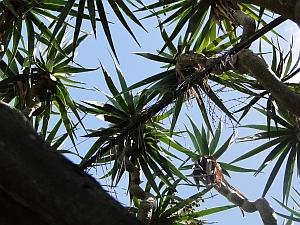 Dragon's blood tree leaves
Dragon's blood tree leaves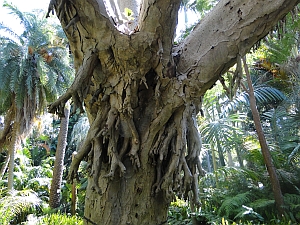 Dragon's blood tree bark with aerial roots
Dragon's blood tree bark with aerial roots******************
Quercus acutissima, known as sawthorn oak or sawtooth oak, has long leaves with interesting margins. Each tooth at the end of the vein has a little bristle on it as you can see on this autumnal leaf:
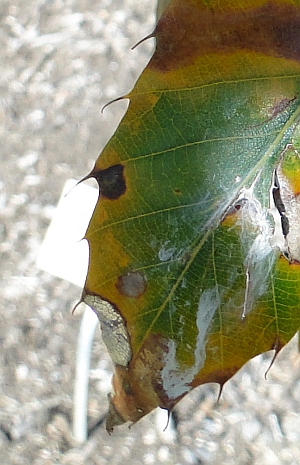 Sawtooth oak leaf margin with bristles
Sawtooth oak leaf margin with bristles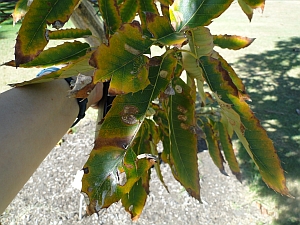 Sawtooth oak leaves
Sawtooth oak leaves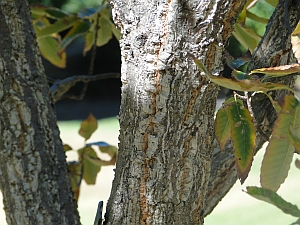 Sawtooth oak bark
Sawtooth oak bark******************
Here's a biggie: Flindersia schottiana, called cudgerie, bumpy ash - or southern silver ash!
What a beautiful tree this is:
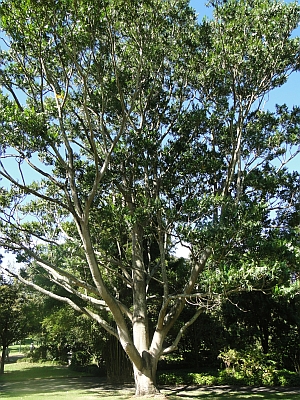 Cudgerie
Cudgerie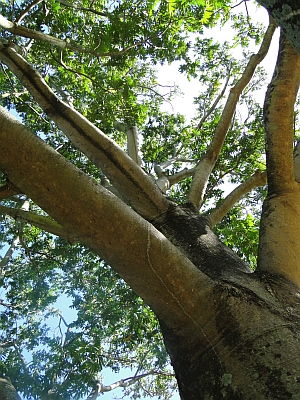 Cudgerie bark
Cudgerie bark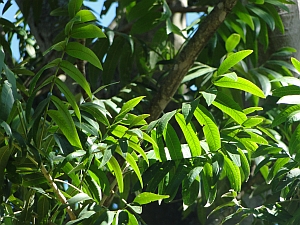 Cudgerie leaves
Cudgerie leaves******************
Melaleuca alternifolia has many names, the most common being tea tree. Tea tree oil is distilled from the leaves, which are rather short and very narrow. The most impressive part of this tree for me was the peeling, papery bark - and in fact one of its other names is the narrow-leaved paperbark:
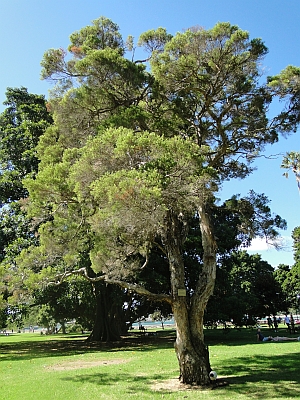 The tea tree
The tea tree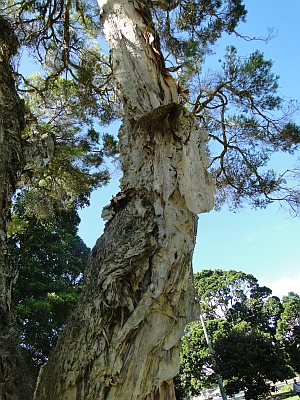 The trunk of the tea tree
The trunk of the tea tree******************
Ficus watkinsiana - the strangler fig :) A giant of a tree, with a superb trunk. According to the label "it starts life as a seedling growing high on existing trees and slowly strangles them as its roots reach the ground" - but I don't know which tree was strangled in this instance:
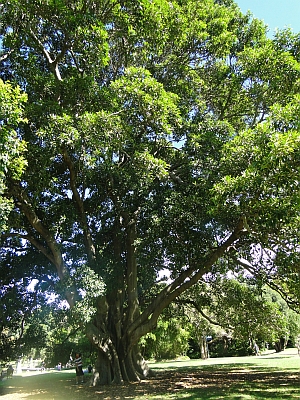 The strangler fig
The strangler fig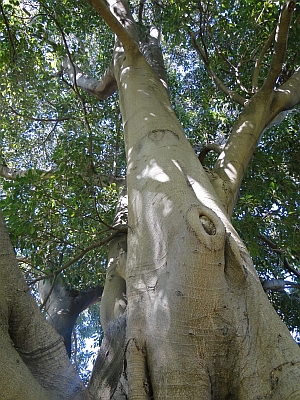 Strangler fig trunk
Strangler fig trunk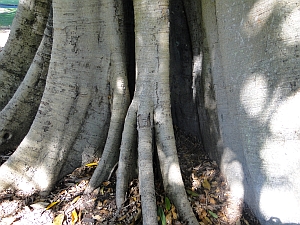 The base of the trunk
The base of the trunk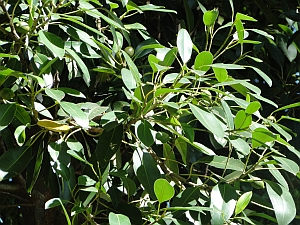 Strangler fig leaves
Strangler fig leaves******************
Heritiera actinophylla or Argyrodendron actinophyllum - take your pick, they both refer to the same tree, the black booyong or black jack. Note the buttress roots - quite a flourish, there, at the bottom of the trunk:
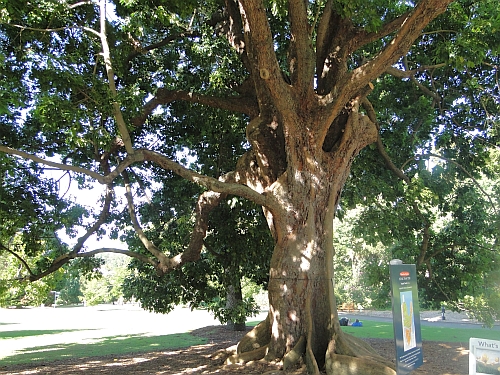 Black booyong tree
Black booyong treeHere's a close-up of those artistic buttresses:
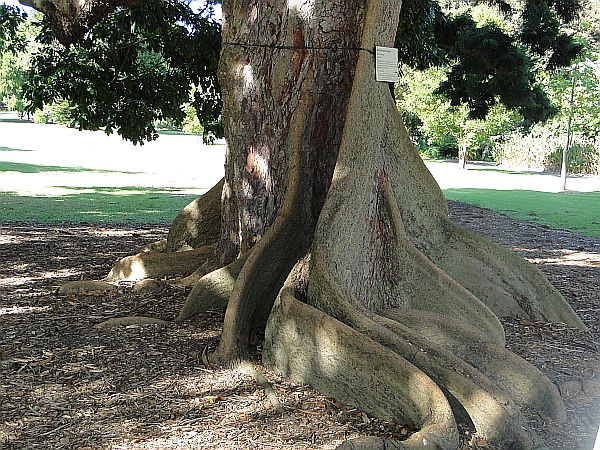 Black booyong buttress roots
Black booyong buttress roots******************
Racing back to the cafe at the end of my walk, I stopped to admire a Norfolk Island pine, Araucaria heterophylla - another tree in the Araucariaceae family:
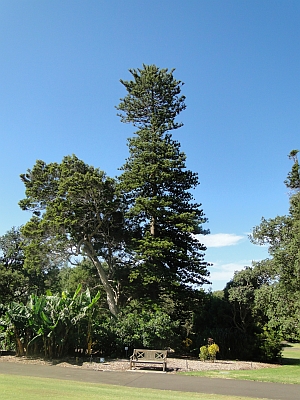 The pine is the taller tree in this pic
The pine is the taller tree in this pic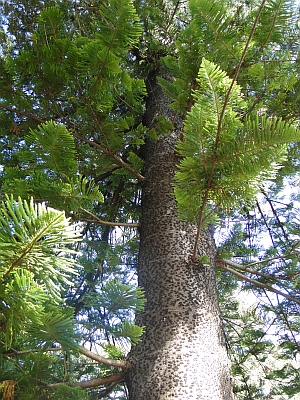 I love the pyramid-shaped branchlets
I love the pyramid-shaped branchlets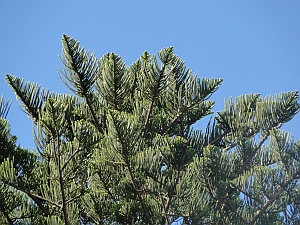 Topmost branchlets
Topmost branchlets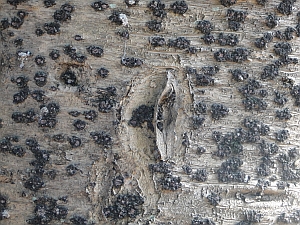 The bark of the Norfolk Island pine
The bark of the Norfolk Island pine******************
I hope you enjoyed this very quick race around Sydney Botanic Garden. I can't wait to be able to write another page about another visit :)